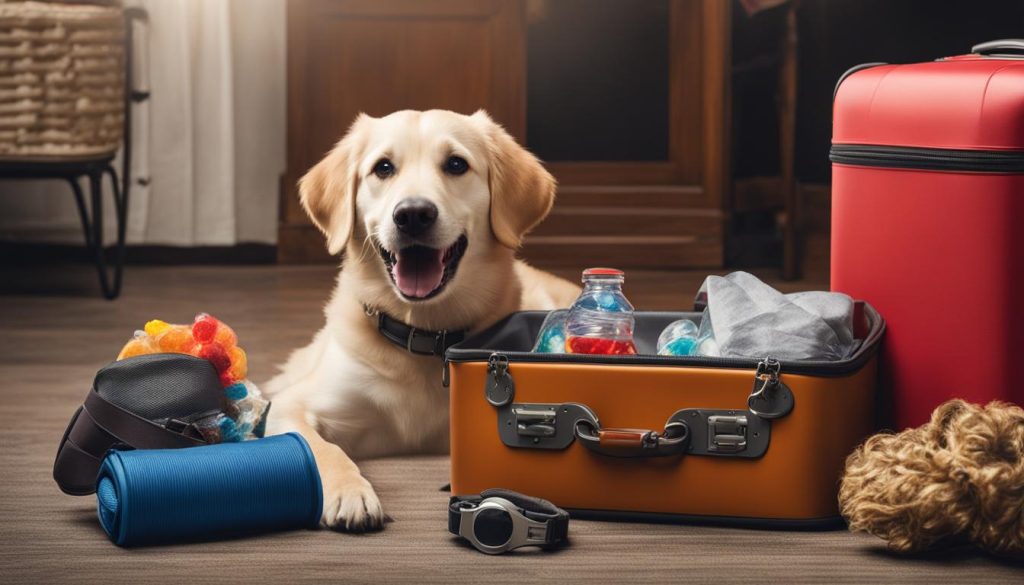If you’ve ever been woken up by the sound of your dog barking in their sleep, you may have wondered why this behavior occurs. Dogs barking during sleep is a common phenomenon, and understanding the reasons behind it can help us better understand our furry friends.
One possible explanation for dogs barking in their sleep is that they are dreaming. Just like humans, dogs have REM (rapid eye movement) sleep, which is the stage of sleep associated with dreaming. During this stage, dogs may act out their dreams, which can include barking, running, or even wagging their tails.
Another reason for sleep barking in dogs could be anxiety or stress. If a dog is experiencing these emotions during their waking hours, it can carry over into their sleep and manifest as barking. Recent traumatic experiences or separation anxiety can also contribute to sleep barking.
Interpreting dog sleep sounds and understanding their sleep behavior can give us insight into their overall well-being. By monitoring their sleep patterns and being aware of any changes or distressing behaviors, we can better care for our canine companions.
- Dogs may bark in their sleep due to dreaming or as a reaction to anxiety and stress.
- Understanding a dog’s sleep behavior can provide insights into their well-being.
- Monitoring sleep patterns and seeking professional advice can help address sleep barking.
- Interpreting dog sleep sounds can help identify any underlying issues or discomfort.
- Creating a comfortable sleeping environment can promote healthy sleep behavior in dogs.
Do Dogs Have Nightmares?

While there is no scientific evidence to definitively prove that dogs have nightmares, many pet owners report that their dogs appear to have bad dreams. Dogs may dream about things that cause them anxiety or fear, such as traumatic experiences or loud noises. On the other hand, they may also dream about pleasant experiences, like playing with their owners. More research is needed on this topic to fully understand the extent and nature of dog dreams.
Although dogs can’t verbalize their dreams, their behaviors during sleep can provide insight into their dream content. Dogs may twitch, whimper, or show signs of distress while dreaming, suggesting that they may be experiencing nightmares. However, not all dream-related behaviors indicate a nightmare. Dogs also engage in normal dream activity, such as running in their sleep or making soft noises.
It’s essential to create a comfortable sleeping environment for your dog to ensure restful sleep. Providing a cozy bed, limiting exposure to loud noises, and maintaining a consistent routine can all contribute to better sleep quality. If you suspect that your dog is experiencing frequent nightmares or their sleep behavior is causing distress, consulting with a veterinarian or animal behaviorist can provide further guidance and support.
Why Do Dogs Bark While They Sleep?

Dogs may bark in their sleep for various reasons. One possible explanation is that they are simply dreaming and reacting to their dreams by barking. Similar to humans, dogs can dream during their sleep and may act out their dreams through vocalizations like barking. Another reason for sleep barking could be anxiety or stress, which can carry over from their waking hours into their sleep. Dogs may experience fear or worry while they sleep, leading to vocalizations such as barking. Traumatic experiences or separation anxiety can also contribute to sleep barking, as these factors can cause heightened stress levels in dogs.
Additionally, physical factors such as discomfort or pain can cause dogs to bark in their sleep. It is important to consider the overall sleep behavior and patterns of the individual dog to determine the specific cause of sleep barking. If a dog consistently barks during sleep or exhibits signs of distress while sleeping, it may be beneficial to consult with a veterinarian. They can provide a thorough evaluation and offer recommendations or treatment options to address the underlying causes of sleep barking.
Understanding why dogs bark while they sleep can help pet owners provide appropriate care and support for their furry companions. By recognizing the potential reasons behind sleep barking, owners can take steps to alleviate stress, create a comfortable sleeping environment, and ensure their dog’s overall well-being.
Possible Causes of Dog Sleep Barking:
- Dreaming and reacting to dreams
- Anxiety or stress
- Traumatic experiences or separation anxiety
- Physical discomfort or pain
What should I do if my dog barks in its sleep?

If your dog barks in its sleep, it can be a bit concerning, but there are a few steps you can take to handle the situation appropriately. While it may be tempting to wake your dog up when they start barking, it’s generally best to let them sleep undisturbed. Abruptly waking a sleeping dog can disorient them and make it difficult for them to return to a restful sleep state.
However, it’s important to monitor your dog’s behavior and assess whether the barking becomes more frequent or seems distressing. If this is the case, it may be worth consulting with a veterinarian. They can help determine if there are any underlying causes or conditions contributing to the sleep barking and provide guidance on how to address it.
In the meantime, there are a few things you can do at home to help alleviate any sleep disturbances caused by your dog’s barking. Creating a calm and comfortable sleeping environment can make a difference. Ensure that your dog has a cozy bed or crate in a quiet area of your home, away from any potential sources of noise or distraction.
Establishing a bedtime routine can also be beneficial. This can include activities that help your dog relax, such as a short walk or gentle playtime before bed. Additionally, keeping a consistent sleep schedule for your dog can help regulate their sleep patterns and minimize any disruptions.
Handling dog sleep barking: Tips and Tricks
- Avoid waking your dog when they bark in their sleep, as it can disrupt their sleep cycle.
- Monitor your dog’s behavior and consult with a veterinarian if the sleep barking becomes frequent or distressing.
- Create a calm and comfortable sleeping environment for your dog by providing a cozy bed or crate in a quiet area of your home.
- Establish a bedtime routine that includes relaxing activities before sleep.
- Maintain a consistent sleep schedule for your dog to help regulate their sleep patterns.
By following these steps and seeking professional guidance if needed, you can help manage your dog’s sleep barking and ensure they have a restful night’s sleep. Remember to be patient and understanding as you work through this behavior, as it may take time for your dog to adjust and find a comfortable sleep routine.
What do dogs dream about?

While we can’t ask dogs directly about their dreams, their behaviors during sleep give us some insights into what they might be dreaming about. Dogs, like humans, go through different sleep stages, including REM (rapid eye movement) sleep, which is associated with dreaming. During REM sleep, dogs may exhibit various behaviors and movements that indicate they are experiencing vivid dreams.
One common behavior seen in dogs during REM sleep is muscle twitches or jerking movements. This suggests that they are engaged in some sort of physical activity in their dreams, such as running, playing, or chasing. Dogs may also make vocalizations, including barking, growling, or whimpering, which further supports the idea that they are dreaming about specific experiences or interactions.
Table: Common Dream Behaviors in Dogs
| Dream Behavior | Possible Interpretation |
|---|---|
| Muscle Twitches | Engaged in physical activity |
| Vocalizations (barking, growling, whimpering) | Reacting to dream experiences |
| Paw Movements | Interacting with objects or playing |
| Rapid Eye Movements | Visual processing and vivid dreaming |
Please be aware that the content of a dog’s dreams can vary from one individual to another. They may dream about recent events, such as playing fetch in the park or interacting with other dogs. Dogs with a history of anxiety or fear might also dream about situations that cause them distress. On the other hand, dogs who have had positive experiences and social interactions may dream about those pleasant moments.
Ultimately, while we may not know the exact specifics of a dog’s dream content, their behaviors during sleep suggest that they do indeed dream and that their dreams are influenced by their experiences and emotions.
Wrapping Up

Dogs barking in their sleep is a common behavior that can be attributed to various factors. Dogs may bark in their sleep due to dreaming, anxiety, stress, or physical discomfort. It is important for pet owners to monitor their dog’s sleep behavior and patterns to identify any potential underlying issues. Overall, allowing dogs to complete their sleep cycle undisturbed and providing a comfortable sleeping environment can help promote healthy sleep behavior in dogs.
Understanding dog sleep behavior is crucial for ensuring the well-being of our furry friends. Dogs, like humans, have different sleep patterns and behaviors. They may experience dreams during sleep, which can manifest as barking or running. It is also important to consider any sources of anxiety or stress that the dog may be experiencing, as these can contribute to sleep barking. By monitoring their sleep patterns and behaviors, pet owners can gain insights into their dog’s overall health and address any potential issues.
The Importance of Monitoring Dog Sleep Patterns
Monitoring dog sleep patterns is essential for detecting any changes or abnormalities. By observing their sleep behavior, pet owners can identify any signs of discomfort, pain, or distress. This can help in early detection of potential health issues and prompt veterinary intervention if needed. Additionally, monitoring sleep patterns can provide valuable information about the effectiveness of any interventions or changes made to the dog’s sleep environment or routine.
Understanding Dog Sleep Behavior
- Dogs may bark in their sleep due to dreams, anxiety, stress, or physical discomfort.
- Monitoring sleep patterns can help identify any underlying issues and ensure the dog’s overall well-being.
- Providing a comfortable sleeping environment promotes healthy sleep behavior in dogs.
- Regular veterinary check-ups are important for addressing any sleep-related concerns.
By understanding and monitoring dog sleep behavior, pet owners can ensure that their furry friends have restful and rejuvenating sleep. This can contribute to their overall physical and mental health, making for a happier and healthier canine companion.
How to Crate Train a Rescue Dog with Separation Anxiety
Crating training can be a valuable tool in helping a rescue dog with separation anxiety. By providing a safe and secure space, a crate can help alleviate the dog’s anxiety and create a sense of routine and consistency. Here are some steps to effectively crate train a rescue dog with separation anxiety:
- Introduce the crate gradually: Start by introducing the crate as a positive and comfortable space. Place treats, toys, and bedding inside to entice the dog to explore. Encourage them to enter the crate on their own, using positive reinforcement and praise.
- Associate the crate with positive experiences: Feed the dog their meals near the crate or place their favorite toys inside. Gradually move the food or toys into the crate to create positive associations with being inside.
- Practice short periods of confinement: Once the dog is comfortable entering the crate voluntarily, gradually increase the amount of time they spend inside. Start with short periods and gradually extend the time, always ensuring the dog remains calm and relaxed.
- Use desensitization techniques: If the dog shows signs of anxiety or distress, such as whining or pacing, it’s important to proceed at a slower pace. Use desensitization techniques, such as leaving the crate door open and gradually closing it for short periods, until the dog is comfortable being fully confined.
- Provide calm and comforting environment: Make the crate a comfortable and inviting space by adding soft bedding and familiar toys. Play calming music or use pheromone diffusers to promote a sense of calmness.
Remember, crate training requires patience and consistency. It’s important to never use the crate as a form of punishment and to always provide positive reinforcement and rewards for appropriate behavior. Seeking guidance from a professional trainer or behaviorist can also be beneficial in successfully crate training a rescue dog with separation anxiety.
Frequently Asked Questions:
Q: Can crate training help with separation anxiety in rescue dogs?
A: Yes, crate training can be an effective tool in helping rescue dogs with separation anxiety. It provides them with a safe and secure space, creates a sense of routine, and helps alleviate anxiety.
Q: How long does it take to crate train a rescue dog?
A: The time it takes to crate train a rescue dog can vary depending on the individual dog and their previous experiences. Consistency, patience, and positive reinforcement are key to successful crate training.
Table: Crate Training Schedule
| Week | Training Steps |
|---|---|
| 1 | Introduce the crate and encourage exploration |
| 2 | Associate the crate with positive experiences (feeding, toys) |
| 3 | Practice short periods of confinement |
| 4 | Gradually increase the duration of crate confinement |
| 5 | Continue reinforcing positive behavior and use desensitization techniques |
| 6 | Review progress and make any necessary adjustments |
Remember to tailor the training schedule to your dog’s individual needs and progress at a pace that is comfortable for them. Consistency, patience, and positive reinforcement are key to successful crate training.
Why is My Dog Afraid of the Grass? Expert Tips for Overcoming Fear
Many dog owners have experienced their furry friends displaying fear or anxiety when encountering grass. This unusual behavior can leave owners puzzled and concerned. Understanding why dogs may be afraid of grass and how to help them overcome this fear is essential in ensuring their overall well-being.
There can be various reasons why a dog may develop a fear of grass. It could be due to a negative experience, such as getting injured or stung by insects while walking on grass. Some dogs may also have sensory sensitivities to the texture or smell of certain types of grass. Regardless of the cause, it is important to address this fear to prevent it from escalating and impacting the dog’s quality of life.
One effective technique for helping dogs overcome their fear of grass is desensitization. This involves gradually exposing the dog to the grass in a controlled and positive manner. Start by allowing the dog to observe the grass from a distance, rewarding calm behavior with treats and praise. Over time, gradually decrease the distance between the dog and the grass, always ensuring that the dog feels safe and comfortable. With patience and consistency, the dog can learn to associate grass with positive experiences, gradually reducing their fear.
It is important to approach the desensitization process at the dog’s pace, avoiding any force or coercion. Patience, positive reinforcement, and reassurance are key in helping the dog build confidence and overcome their fear. Seeking guidance from a professional dog trainer or behaviorist may also be beneficial in developing a tailored desensitization plan for your furry friend.
9 Essential Items to Bring When You Board Your Dog

When it comes to boarding your dog, it’s important to pack the necessary essentials to ensure their comfort and well-being during their stay. Whether you’re leaving them at a boarding facility or with a trusted pet sitter, here are the 9 essential items you should bring:
- Food and treats: Pack enough of your dog’s regular food to last the duration of their stay. This helps maintain their diet and prevents any digestive issues that may arise from sudden changes in food.
- Medication: If your dog requires any medication, ensure you provide clear instructions and pack the necessary dosage for the entire boarding period.
- Bedding and toys: Bring familiar bedding or toys that your dog is accustomed to. Having something familiar can help them feel more secure and relaxed in their temporary environment.
- Leash and collar: It’s essential to provide a leash and collar for your dog. This ensures they can be safely walked and identified while in the care of the boarding facility.
- Vaccine records: Make sure to bring your dog’s up-to-date vaccination records. This helps ensure the safety and well-being of all the dogs at the boarding facility.
- Emergency contact information: Provide the boarding facility with your contact information, as well as the contact information of a trusted emergency contact, in case they need to reach you during your dog’s stay.
- Special instructions: If your dog has any specific needs or behavior considerations, such as dietary restrictions or anxiety triggers, be sure to communicate these clearly to the boarding facility.
- Grooming supplies: If your dog requires specific grooming supplies, such as brushes or shampoo, pack them along to maintain their grooming routine.
- Comfort items: Consider bringing along a comforting item, like a blanket or clothing item with your scent. This can help ease any separation anxiety your dog may experience.
By packing these essential items, you can help ensure that your dog has a comfortable and stress-free boarding experience. Remember to communicate openly with the boarding facility and provide any necessary information to make your dog’s stay as enjoyable as possible.
Uncovering the Truth: Why Does Your Dog Climb on the Couch?
Understanding dog behavior is key to addressing the issue of dogs climbing on the couch. This behavior can have various motivations, and it’s essential to uncover the underlying reasons.
Dogs may climb on the couch to seek comfort and relaxation. The couch provides them with a soft and elevated space where they can feel safe and secure. It’s important to provide alternate cozy spots for your dog, such as a plush bed or a designated area with their favorite blankets and toys. This will help redirect their need for comfort away from the couch.
Another reason dogs climb on the couch is to mark their territory. By leaving their scent on the couch, they are claiming it as their own. To discourage this behavior, consider implementing consistent and positive reinforcement training. Teach your dog a specific command, such as “off” or “bed,” and reward them when they obey. Additionally, using deterrents like pet-safe sprays or covers on the couch can help discourage them from climbing on it.
To foster understanding of your dog’s behavior, it’s important to remember that dogs are social animals that seek interaction and companionship. Climbing on the couch may be their way of joining the family or seeking attention. Ensuring they receive ample mental and physical stimulation through daily exercise, interactive play, and training sessions can help reduce their desire to climb on the furniture.
FAQ
Why do dogs bark in their sleep?
Dogs may bark in their sleep due to dreaming, anxiety, stress, or physical discomfort.
Do dogs have nightmares?
While there is no scientific evidence to definitively prove that dogs have nightmares, many pet owners report that their dogs appear to have bad dreams.
Why do dogs bark while they sleep?
Dogs may bark in their sleep due to dreaming, anxiety, stress, physical discomfort, or recent traumatic experiences.
What should I do if my dog barks in its sleep?
It is generally best not to wake a sleeping dog abruptly. However, if the barking becomes more frequent or distressing, it may be worth consulting with a veterinarian.
What do dogs dream about?
The exact content of a dog’s dreams is unknown, but it is believed they may dream about activities and experiences they have had during the day.
How to crate train a rescue dog with separation anxiety?
Crate training can be an effective way to help a rescue dog with separation anxiety. It is important to approach crate training with patience and consistency.
Why is my dog afraid of the grass?
A dog’s fear of grass can be caused by various factors, such as previous negative experiences or sensitivities to certain textures.
What are the essential items to bring when you board your dog?
Essential items to bring when boarding a dog may include their regular food and treats, medication if necessary, familiar bedding or toys, and any specific instructions or information for the boarding facility.
Why does your dog climb on the couch?
Dogs may climb on the couch for various reasons, including seeking comfort, marking territory, or simply because they find it enjoyable.






